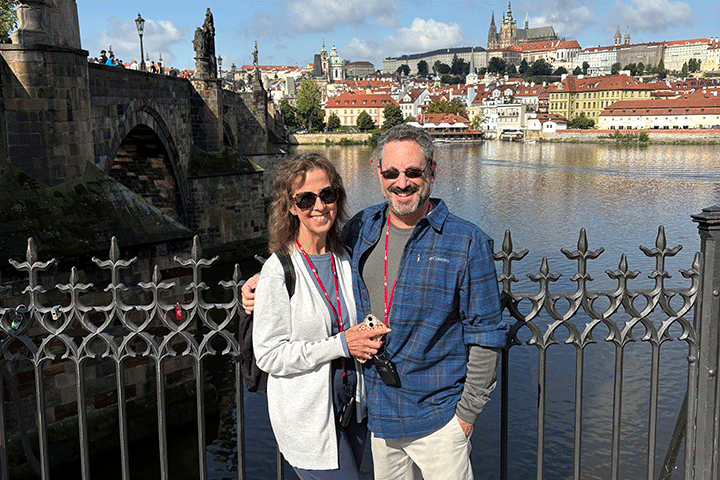An Unexpected Diagnosis After Surgery

- Whipple procedure provides surprise pancreatic cancer diagnosis
- Stereotactic body radiation therapy (SBRT) for a first clinical trial
- Second trial of standard treatment used in a new way
- Third trial includes vaccines
I am a pancreatic cancer survivor.
After three bouts of acute pancreatitis—for no known reason—over a two-year period, I went to Hershey Medical Center for an endoscopic ultrasound (EUS) and biopsy on a pseudocyst. The tests showed I had a rare benign mucinous cyst that had to be removed via a Whipple procedure. I knew from my days in nursing school that a Whipple was serious, so I asked a friend who is a doctor to refer me to someone for a second opinion; he sent me to Dr. Christopher Wolfgang at Johns Hopkins (now at NYU Langone in New York).
A Surprise Diagnosis
Dr. Wolfgang confirmed the need for the Whipple, so on August 14, 2013, I underwent surgery at Johns Hopkins. I awoke after an eight-hour surgery that was supposed to be six hours to a very nervous, uncomfortable-looking family. Before my surgery, my big, loud, Italian family couldn’t laugh hard enough—an innate inappropriate effect in the face of great anxiety. But now, in the ICU, at first glance, four of my six children, husband, and sisters looked distressed. It was in that moment that I learned that an adenocarcinoma—a malignant tumor—was discovered along with the cyst; I had pancreatic cancer.
Treatment and Clinical Trials
Over the following year, I went through three clinical trials at Hopkins. First, I underwent stereotactic body radiation therapy (SBRT) with Dr. Joseph Herman (now at Northwell Health in New York). The treatment was for 45 minutes a day over five days, and I received a lifetime dose of radiation in one week.
Dr. Dung Le, my oncologist, had me undergo 12 rounds of FOLFIRINOX chemotherapy—a rigorous mix of three chemo drugs and a super vitamin—in the form of an eight-hour infusion every two weeks. FOLFIRINOX is usually used for metastatic cancer; the trial was to determine if it is effective for earlier stage cancers. A few days after each chemo treatment I ended up hospitalized due to dehydration and intractable abdominal pain. My beautiful long, curly hair became other-worldly in texture and eventually nonexistent. Pushing the button on the TV remote control became an aerobic activity as I endured the grueling side effects of the FOLFIRINOX. I did all 12 rounds of chemo on schedule, on dose, with a smile on my face; I’m proud of that. My friends and family helped in innumerable ways!
Presently, every six months I go to Hopkins for a CT scan, low-dose chemo with Cytoxan to suppress my immune system, and then six experimental vaccines. The vaccines are trying to teach my immune system to recognize and kill cancer cells. So far, I remain cancer-free.
Advice for Other Patients
The Internet is a terrifying place for someone newly diagnosed with pancreatic cancer. I am here to tell you: THERE IS HOPE!!! Here’s my advice:
- Be your best advocate.
- Get a second opinion at a large educational institute—my second opinion at Hopkins saved my life, and I will be forever grateful to my treatment team.
- Let friends and family help – they need to, and you need them.
- For those who have their faith let it carry you; my faith has been a big support to me.
I run a support group for pancreatic cancer patients and caregivers designed to be safe, hopeful, uplifting, and joyful. I also started the central Pennsylvania chapter of The National Pancreas Foundation (NPF) to raise money and awareness for pancreatic cancer research. I would never choose this journey, but I am grateful for it, for I have seen the best of humanity because of it. The kindness, compassion, service and love that come through others are what will help us find a cure.
After almost 10 years and multiple clinical trials, Lora succumbed to pancreatic cancer. As a nurse she understood the importance of trials to help herself and others that come after her. We offer our deepest condolences to her family.






